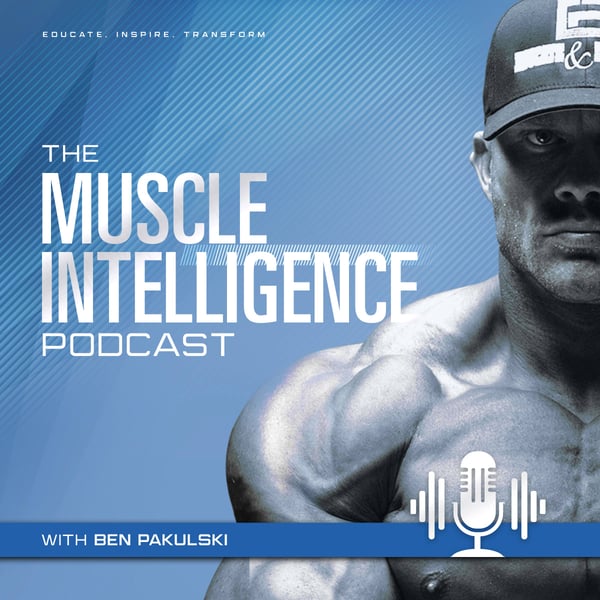Six-Pillar Series: Training and Movement Optimization #361
Muscle Intelligence
Ben Pakulski
4.8 • 745 Ratings
🗓️ 30 October 2023
⏱️ 62 minutes
🧾️ Download transcript
Summary
How well you move is a MAJOR marker of longevity. This incorporates everything from your grip strength, to how adept you are at moving on and off of the ground without your hands. Training itself, but also movement in your daily life, should be purposeful.
Today, you'll hear from Dr. Stuart McGill on how to keep the spine healthy as you age, Greg Roskopf on the incredible ways the musculoskeletal system influences your nervous system, Jay Campbell on a simple strategy to incorporate cardio into your workouts, and myself - I’ll debrief you on my top tips to build your legs.
In today’s episode, you’ll learn:
- The Reason You MUST do Cardio
- How to Balance Joint Health and Heavy Lifting
- A Framework for MAXIMUM Leg Gains
- How Muscle Tone Affects Your Nervous System
– About Muscle Intelligence –
We are raising the standard of men in their prime by helping aspirational men optimize their health so they can live longer, lead from the front and perform at their best everyday.
Learn more: muscleintelligence.com/mipapply
Support our Sponsors:
- Get a 20% discount on all Organifi products at organifi.com/muscle
- Get a 10% discount on all BiOptimizers products at bioptimizers.com/muscle - use code MUSCLE10
Full episodes with Featured Guests:
- Back Pain Treatment, Prevention and Insights from Leading Spine Expert Dr. Stuart McGill
- Muscle Activation Techniques for Strength & Neuromuscular Function with Greg Roskopf
- How to Optimize Testosterone Levels for Longevity with Jay Campbell
- Training Toolkit to Build Leg Muscles Fast and Effectively
Join the Mission:
- Private Email List: muscleintelligence.com/viplist
- Private Community: muscleintelligence.com/community
- Instagram: instagram.com/muscleintelligencecoaching
- YouTube: muscleintelligence.com/youtube
Transcript
Click on a timestamp to play from that location
| 0:00.0 | One thing that came up as you're talking there is it sounds like most, you could obviously |
| 0:14.8 | correct me at any point if I'm incorrect. It sounds like most back injuries are repetitive strain, |
| 0:19.6 | repetitive trauma, we do the same thing over and over and over |
| 0:21.4 | again. But that make an argument then for training with isometrics as far as like my goal is to |
| 0:26.9 | accumulate strength in certain, you know, length, length tension relationships with specific muscles. |
| 0:32.6 | Well, the answer is yes and no, but it needs a context. Sure. So if we were to take a Jiu-Jitsu master, folks are aware of what that is now because of MMA, the, you know, if you take Gracie Jiu-Jitsu, for example, basically you require your spine to become a boa constrictor in athleticism. Some people, if you're a real gracing practitioner, |
| 0:58.0 | you don't put a lot of force into that. In fact, if you're going for a move that requires a lot |
| 1:03.3 | of force in a highly deviated position, they will abandon the approach, set up the next |
| 1:08.9 | submission attempt and try for that. So not require high strength. |
| 1:14.1 | When you take a highly deviated spine and then put high strength through it, you've really |
| 1:19.8 | created a stress concentration on the disc and you'll get into trouble. |
| 1:25.4 | So it's sports specific and it's technique specific. You cannot do |
| 1:32.4 | isometrics if you're a Gracie, uh, jiu jiu jitzu, elite practitioner. Because the stress strain |
| 1:40.8 | reversals on the collagen fibers will slowly delaninate them. |
| 1:45.6 | Even without movement. |
| 1:47.1 | Oh, no, I'm talking about if they are practicing jiu-jitsu. |
| 1:50.1 | It wouldn't be a good preparation to do isometrics for a jujitsu player, but my point in all |
| 1:57.2 | of that is don't use heavy load. You can use the motion, but not the load. |
| 2:03.5 | I'm going to regress one level. In terms of disc injury, what causes cumulative injury is power, |
| 2:12.9 | force times velocity. So a golfer, a jiu-jitsu practitioner, has a lot of velocity, a lot of motion. Keep the force |
| 2:21.4 | slow. If you're a power lister or a bodybuilder with high force, keep the motions low. So you can do |
| 2:29.4 | spine isometrics and high volume heavy repeated loading. But you know, I know who I'm talking to |
... |
Please login to see the full transcript.
Disclaimer: The podcast and artwork embedded on this page are from Ben Pakulski, and are the property of its owner and not affiliated with or endorsed by Tapesearch.
Generated transcripts are the property of Ben Pakulski and are distributed freely under the Fair Use doctrine. Transcripts generated by Tapesearch are not guaranteed to be accurate.
Copyright © Tapesearch 2025.

